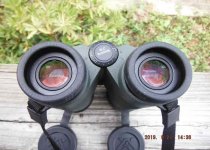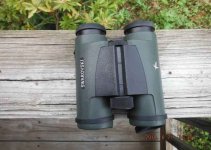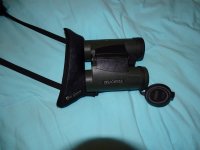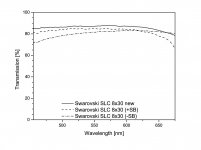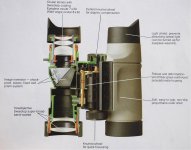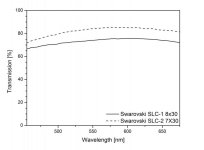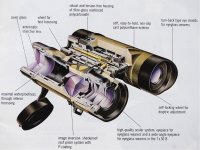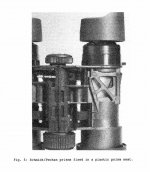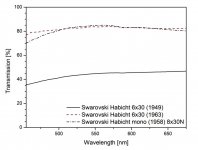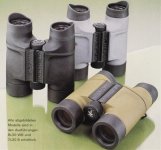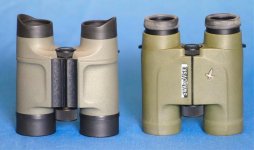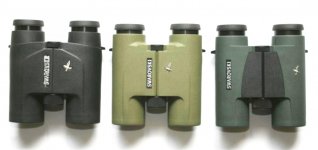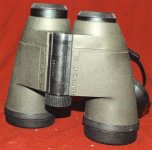SLC x30 History & Versions
Expanding on my previous posts about the SLC neu 8x30’s, this seems to be a convenient place to include the history of all the SLC x30 variations
The SLC x30’s were made for 27 years from 1985 to 2011:
- the 8x30 was introduced in 1985, and the last I’ve observed is dated February 2011 (D8104)
- the 7x30 was introduced in 1986, and the last I’ve observed is dated May 2001 (D7118)
The 8x30 SLC was replaced in 2011 by the 8x30 and 10x30 CL models
(the 8x32 and 10x32 EL models had been introduced in 2003, with the x32 EL Swarovision models following in 2011)
The SLC x30’s were the first Swarovski binoculars to use roof prisms, specifically Schmidt-Pechan’s
And for some context:
- the first Swarovski product to use roof prisms was the AZF draw tube telescope introduced in 1967, with Abbe-Koenig prisms
- in contrast, both the DT binocular telescopes introduced in 1982, and the fixed tube AT/ ST telescopes introduced in 1991, used Porro prisms, and
- roof prisms were not used in fixed tube telescopes until the ATS/ STS series introduced in 2002, with Schmidt-Pechan prisms
A) Different Marks
During the 27 year production of the SLC x30’s there were a number of changes, some major and others minor
Swarovski specifically identified some - but not all - by designating them as different Marks
And although I’ve seen people group the various changes up to Mark VI, the Marks below are those that I’ve identified as being used by Swarovski
Mark I
The original versions introduced in 1985 and 1986 were respectively the 8x30 W and the 7x30 B, with W indicating a wide angle of view, and B long eye relief
Both were externally focused via a shared tele-objective featuring an air spaced doublet
- see the cross section of a Mark I 7x30 B; per Henry Link:
https://www.birdforum.net/showpost.php?p=2215925&postcount=237
The 2 models differed in eyepiece construction, and the longer eye relief 7x30 can be visually recognised by its larger diameter eye lens
From their introduction, the SLC’s had Swarotop multi-coating
A graph showing the transmission performance of 2 early units can be found in Gijs van Ginkel’s presentation on Swarovski Optik
see ‘History and quality development of Swarovski Optik 1935-present time’ at:
https://www.houseofoutdoor.com/verrekijkers/verrekijkers-testen-en-vergelijken/
As can be seen by comparison to the graph in my previous post, there was a significant increase in the performance of the SLC’s in the 20 years from 1985
Mark II
In 1989, Swarovski upgraded the original x30 by:
- phase coating the 2 roofed surfaces of the prisms
- sealing the unit with a planar glass at the front of the objective housing, and
- revising the optical design
As the new version was designated Mark II, the original became Mk I
Phase coating was developed and first used by Zeiss in 1988, and then was quickly adopted by other manufacturers
It was a significant advance for roof prisms as it eliminated the inherent slight softness to the image, due to the de-phasing of the light column as it was reflected from the 2 roofed surfaces
The units were sealed by the expedient of placing a flat glass on the front of the previously open objective housings
- see the cross-section of a Mark II 8x30 WB; again per Henry Link:
https://www.birdforum.net/showpost.php?p=2215889&postcount=235
The original tele-objective was replaced by a shared conventional cemented doublet which continued to provide the focusing function
And the 8x30 had the new designation of 8x30 WB, indicating longer eye relief - which required a more complex eyepiece
For easy visual distinction:
- the Mk II is readily distinguished by the closed front to the objective housings, and
- the 8x30 WB eye lens is the same diameter as that of the 7x30 B, verses the smaller one of 8x30 W
As can be seen from the image, the x30’s have a complex skeletonised body. And an alternate view can be seen in the image from the 1991 paper ‘Progress in Binocular Design’ by Konrad Seil
- the 2.1 MB paper is at:
https://wp.optics.arizona.edu/optomech/wp-content/uploads/sites/53/2016/10/Seil-1991.pdf
From this point on the optical design remained the same, though there were upgrades to the various coatings
continued . . .




